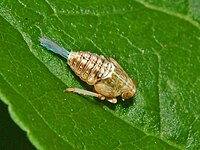Issidae
| Issidae Temporal range:
| |
|---|---|

| |
| Issus coleoptratus | |
| Scientific classification | |
| Kingdom: | Animalia |
| Phylum: | Arthropoda |
| Class: | Insecta |
| Order: | Hemiptera |
| Infraorder: | Fulgoromorpha |
| Superfamily: | Fulgoroidea |
| Family: | Issidae Spinola, 1839 |
| Subfamilies and Tribes | |
Issidae is a family of planthoppers described by Spinola in 1839, belonging to the order Hemiptera, suborder Auchenorrhyncha superfamily Fulgoroidea.
Distribution[]
Species of this family are present throughout the Northern Hemisphere.
Description[]

Issidae are small insects generally with a stocky body, as the wings mainly develop in width. Basic body coloration is not striking, usually shows brownish colors. The head has two ocelli. The forewings have strong pronounced ribs. They wrap the abdomen when the insect is at rest. The family originally included approximately 1000 species with 215 genera, but the systematics of Issidae remains uncertain, with many of the subfamilies having been recently removed to separate families, including Caliscelidae. Nogodinidae, and Tropiduchidae.
In 2013, scientists described a biologically unique set of mechanical gears in an Issus nymph, though identical structures are known in most planthoppers, and were known for decades[1] before the function of the gears was discovered[2]
Taxonomy[]
The family Issidae was once large and included many groups which are now treated in other families or as families themselves. These groups include the Caliscelidae, Nogodinidae, and Tropiduchidae (e.g., subfamilies Tonginae and Trienopinae). Around 2003, there was a view in favour of a single subfamily Issinae, but the current consensus is placement in four (as below). The Catalogue of Life[3] lists genera in five tribes Issini, Parahiraciini, Hemisphaeriini and . The tribe Colpopterini[4] have now been placed in family Nogodinidae Melichar, 1898 having been raised to a subfamily.[5] The oldest fossil of the group is of the Paleocene Menat Formation of France, belonging to the tribe Hysteropterini, molecular clock calibrations suggest a diversification during the Upper Cretaceous.[6]
Subfamilies, Tribes and selected Genera[]
Fulgoromorpha Lists On the Web[7] lists four subfamilies:
Hemisphaeriinae[]
Authority: Melichar, 1906
- Hemisphaeriini Melichar, 1906
- Kodaianellini Wang, Zhang & Bourgoin, 2016
- Parahiraciini Cheng & Yang, 1991
- † Gnezdilov & Bourgoin, 2016 Baltic amber, Eocene (Priabonian)
- Sarimini Wang, Zhang & Bourgoin, 2016
- Hemisphaeriinae incertae sedis
Hysteropterinae[]
Authority: Melichar, 1906; there are currently 61 genera including:
- Agalmatium Emeljanov, 1971
- Falcidius Stål, 1866
- Hysteropterum Amyot & Audinet-Serville, 1843 - type genus
- † Bourgoin & Nel, 2020 Menat Formation, France, Paleocene (Selandian)
Issinae[]
The monotypic subfamily contains tribe Issini Spinola, 1839[8] and has a widespread distribution in Europe, the Middle East and temperate Asia.[9] There are currently four genera:
- † Haupt, 1956 Germany, Eocene (Lutetian)
- Issus Brullé, 1832 – type genus
- Dlabola, 1974
- Wang, Shi & Bourgoin, 2018
Thioniinae[]
Authority: Melichar, 1906 There are currently 3 tribes:
- Cordelini Gnezdilov, 2019 (1 genus)
- Gnezdilov, 2019
- Guianaphrynini Gnezdilov, 2018 (1 genus)
- Gnezdilov, 2018
- Melichar, 1906 (14 genera)
- Fennah, 1947
- Uhler, 1895
- Thionia Stal, 1859
- Gnezdilov & Bartlett, 2018
Issidae incertae sedis[]
Twenty genera are currently placed here:
- Gnezdilov & O'Brien, 2006
- Gnezdilov & O'Brien, 2008
- Gnezdilov & O'Brien, 2008
- Gnezdilov & O'Brien, 2006
- Gnezdilov & O'Brien, 2008
- Gnezdilov, 2017
- Caldwell, 1945
- Gnezdilov, 2004
- Walker, 1870
- Gnezdilov & O'Brien, 2008
- Gnezdilov, 2004
- Caldwell, 1945
- Stål, 1866
- Gnezdilov & O'Brien, 2006
- Caldwell, 1945
- Metcalf, 1923
- Ball, 1936
- Ulixes Stål, 1861
- Haupt, 1918
Szwedo 2019, Szwedo 2019 and Szwedo 2019 from the Bembridge Marls, England dating Eocene (Priabonian) were considered members of this family upon description, however, other authors have found assignation to Issidae dubious.[6]
References[]
- ^ K. Sander. 1957. Bau und Funktion des Sprungapparates von Pyrilla perpusilla WALKER (Homoptera - Fulgoridae). Zool. Jb. Jena (Anat.) 75, 383–388
- ^ Burrows, Malcolm; Sutton, Gregory (2013-09-13), "Interacting gears synchronize propulsive leg movements in a jumping insect" (PDF), Science, 341 (6151): 1254–1256, doi:10.1126/science.1240284, hdl:1983/69cf1502-217a-4dca-a0d3-f8b247794e92, PMID 24031019, S2CID 24640726, lay summary – ScienceNews.org
{{citation}}: Cite uses deprecated parameter|lay-source=(help) - ^ Catalogue of life
- ^ Gnezdilov, Vladimir M. (2002). "A new tribe of the family Issidae with comments on the family as a whole (Homoptera: Cicadina)" (PDF). Zoosystematica Rossica. 11 (2): 305–309.
- ^ Fulgoromorpha Lists On the Web (FLOW): Colpopterinae Gnezdilov, 2003 (retrieved 21 July 2020)
- ^ a b Bourgoin, Thierry; Wang, Menglin; Nel, André (2020-01-22). "The oldest fossil of the family Issidae (Hemiptera, Fulgoromorpha) from the Paleocene of Menat (France)". European Journal of Taxonomy (596). doi:10.5852/ejt.2020.596. ISSN 2118-9773.
- ^ Fulgoromorpha Lists On the Web (FLOW): Issidae Spinola, 1839 (retrieved 21 July 2020)
- ^ Spinola M. 1839 - Essai sur les Fulgorelles, sous-tribu de la tribu des Cicadaires, ordre des Rhyngotes. Annales de la Société Entomologique de France. Paris 8: 133-337.
- ^ Fulgoromorpha Lists On the Web (FLOW): Issini Spinola, 1839 (retrieved 21 July 2020)
- W. E. Holzinger, I. Kammerlander, H. Nickel: The Auchenorrhyncha of Central Europe - Die Zikaden Mitteleuropas. Volume 1: Fulgoromorpha, Cicadomorpha excl. Cicadellidae. - Brill, Leiden 2003
- Stephen W. Wilson – Keys to the families of Fulgoromorpha with emphasis on planthoppers of potential importance in the Southern United States -Florida Entomologist 88(4) Fcla.edu
External links[]
- Issidae
- Auchenorrhyncha families
- Fulgoromorpha
- Taxa named by Maximilian Spinola